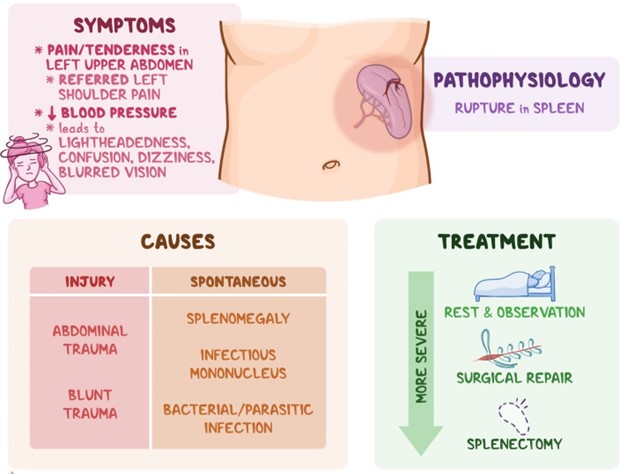A first-response team is working at the location of a bombing incident. A nurse triaging a group of clients should give treatment priority to which of the following clients?
A client who has superficial partial-thickness burn injuries over 5% of his body.
A client who is ambulatory and exhibits manic behavior.
A client who has a rigid abdomen with manifestations of shock.
A client who has a femur fracture with a 2+ pedal pulse.
The Correct Answer is C
This indicates that the client may have internal bleeding, which is a life-threatening condition that requires immediate medical attention. The nurse should provide supportive care, such as administering oxygen, and arrange for rapid transport to a trauma center.
The client with superficial partial-thickness burn injuries over 5% of his body may require medical attention, but this is not immediately life-threatening.
The client who is ambulatory and exhibits manic behavior may require psychological support, but this is not a priority in the acute phase of a traumatic event.
The client who has a femur fracture with a 2+ pedal pulse may require immobilization and pain management, but this is also not a priority in the acute phase of a traumatic event.

Nursing Test Bank
Naxlex Comprehensive Predictor Exams
Related Questions
Correct Answer is C
Explanation
Regular exercise is an essential component of health promotion for older adults. Exercise helps to maintain and improve physical function, mobility, and independence, reduces the risk of falls, and helps to prevent chronic conditions such as diabetes, cardiovascular disease, and osteoporosis. Exercise also has mental health benefits, such as reducing depression and anxiety.
Scheduling annual dental examinations for the clients (A) is important but is not the best health promotion strategy for older adults at an assisted living facility. While dental health is important, exercise is a more comprehensive strategy that addresses multiple aspects of health.
Providing the clients with a low-fat diet (B) is also important for health promotion, but it is not as effective as exercise in promoting physical and mental health.
Immunizing the clients against influenza (D) is important to prevent infection, but it is not a health promotion strategy that addresses overall health and wellbeing.
Correct Answer is A
Explanation
According to the fire safety guidelines for hospitals, the nurse’s priority in this situation is to move the client to another location. This is because the client’s safety and well-being are the most important considerations in a fire emergency. The nurse should move the client to a safe area away from the fire, preferably behind a fire door or in another fire compartment. The nurse should also close the door of the room where the fire is to prevent the spread of smoke and flames.
The nurse should then activate the alarm to alert other staff and the fire department. The nurse should also use a fire extinguisher to attempt to extinguish the fire, if it is safe and feasible to do so. However, the nurse should not put themselves or the client at risk by trying to fight the fire. The nurse should follow the RACE acronym for fire response: Rescue, Alarm, Contain, and Extinguish.
Whether you are a student looking to ace your exams or a practicing nurse seeking to enhance your expertise , our nursing education contents will empower you with the confidence and competence to make a difference in the lives of patients and become a respected leader in the healthcare field.
Visit Naxlex, invest in your future and unlock endless possibilities with our unparalleled nursing education contents today
Report Wrong Answer on the Current Question
Do you disagree with the answer? If yes, what is your expected answer? Explain.
Kindly be descriptive with the issue you are facing.
